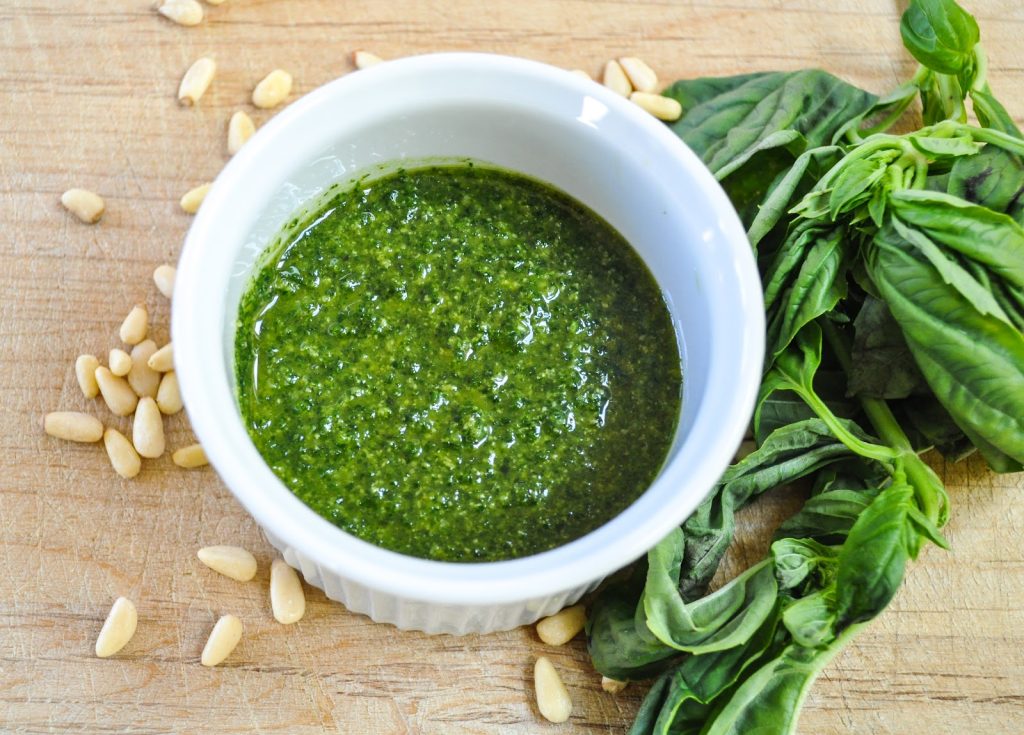Variations on Pesto Pasta
Pesto is a mouthful of bright colors and rich in pure freshness.
With its origins hailing from Genoa, this delectable Italian paste is always made from fresh ingredients and pounded or blended into a paste. Pine nuts, Basil leaves, parmesan cheese, garlic and a generous amount of olive oil are all mixed together to form a wholesome thick green savory paste which is used in pasta, spread on bread, or used as a dip.
History of Pesto
Initially, a roman dish called ‘moretum’ was made by simply throwing in cheese, garlic and herbs into a mortar and pounded with a pestle. When Basil became an essential part of Italian cuisine, primarily in Liguria, this dish was altered to suit their taste buds and outstanding love for basil. This gave birth to the palatable Pesto paste of the 16th century.
The Ligurian lands were infused with rich salts and minerals, perfect for the growth of leafy crops like basil. This heavily influenced their cuisine as basil was used in during all meals. Where other regions incorporated meats prominently in their dishes, Liguria featured herbs, vegetables, fruits, and nuts in their cooking – a clear reflection on their pesto.
The word ‘pesto’ originally derives from the world “pestâ”, meaning to crush or pound – pertaining to its traditional preparation methods. The latter, consequently generated the English word ‘pestle’. The ingredients were customarily pounded with the help of the pestle and grounded nicely with circular motions in the mortar.
Variations of Pesto
Italian cooking styles can incorporate very elaborate cooking, though at time it could be simple. With its broad range, Italian cuisine comes with enormous variations, including an array of recipes able to satiate our individual tastes. Different regions have their own pesto recipe due to the differences in produce available. Pesto is more commonly associated with pasta. With the basic pesto blend, a versatile sauce is created and is absolutely perfect to combine with pasta.
Pesto Alla Genovese
This is by far the closest to the original pesto constituting of sweet Genovese basil, garlic, extra virgin olive oil, pine nuts and grated cheese. With the traditional tools used to grind the pesto, the use a mortar and pestle rather than a food processor is much preferred. When the ingredients are being pounded together, the flavors are absorbed and consequently, merge in harmony. This method is not only used for pesto, but to make all sorts of paste. Chef Federico Michieletto’s of Marini’s on 57 notes that cooking is certainly not only about the end result but the on-going process, as is reflected with the use of the mortar. At Marini’s on 57, time honoured traditional preparation using the mortar and pestle are still practiced by the chefs.
Pistou
A French version of Pesto from the region of Provence is called Pistou. The paste is made only with olive oil, basil, and cheese. In traditional Pistou, pine nuts are absent simply because there were no pine trees. This flavorful paste is traditionally used in soups, but like any condiment can be used as a spread or in pasta.

Pesto Alla Siciliana
Red Pesto (Rosso) is another common variation, similarly made to that of the green pesto (Genovese), but traditionally prepared with the addition of sun-dried tomatoes.
In a unique twist, Sicilian pesto is a paste that includes sun-dried tomatoes with the addition of toasted almonds. The almond blends with the sun-dried tomatoes to form perfection and is perfect used as a dip. On the culinary front, almonds are extremely versatile nuts. They bring a rich creamy texture to dishes, and are even able to enhance certain flavors while providing a heavenly fragrance and enticing scent, giving you a more flavorful dish.
The Chefs at Marini’s on 57 are masters when it comes to the art of incorporating a variety of nuts into their dishes and presentations. For those with nut allergies please inform the reservations team before dining at the restaurant to ensure a more bespoke experience.

Laksa Pesto
Italian cuisine is considered one of the most popular in the world. In fact, its popularity has transcended cultures and influenced cultural dishes aplenty.
In Singapore, a variation of pesto is known as the Laksa pesto. The pesto was taken and fused with the Singaporean palate, in order to accommodate the locals. It has the taste of the popular spicy noodle, Laksa, a Peranakan dish (combination of Malay and Chinese cuisine) but the paste is concocted similarly to that of the green pesto procedure.
The laksa pesto is made with of products that are traditionally or more commonly used in Singaporean cuisine. Cashew nuts take the place of pine nuts while Vietnamese coriander is used instead of Basil. Laksa leaves has a strong aroma that is used most notably in rice noodle dishes.
For the extra richness in taste, fish sauce is added substituting the cheese present in the original Genovese pesto recipe. The differences are only in terms of the ingredients as the procedure is, in fact, similar to that of the Italian pesto; it is either pounded in a mortar or processed in a food processor.



